
BY BOB MILLER
September 7, 2018
Ocean Rescuer, lifeguard and surfer Bob Miller has imparted his water and surfing wisdom with On Montauk all through 2018. We compile it all here in a trilogy of knowledge you should live by, including his last piece on surfing execution, “Part III – Now let’s hit the waves!”
Part I
Let’s Tauk Safety
After over a decade of teaching surfing, two decades of coaching swimming, and nearly three decades of lifeguarding, there is something I’d like to share, which boils down to this; we all want to have fun, right? That’s it, story’s over? Yeah…nah, we have only just begun. But the bottom line… is about having fun.
Remember the old saying that it’s all fun and games until &#*! Well, this is a story trying to prevent the &#*!, and the way to do that is to put safety first. By this I’ll suggest that you do something that you are hopefully doing anyway: be aware of your surroundings. First thing in any first aid response is to survey the scene, look for potential dangers, assess risks…then respond.
When we all walk down to the beach, we take a look at the crowd and decide where to place our things. Perhaps we can also ask ourselves a few things? Is it possible the crowd is in a particular place for a reason, would you think? Possibly everyone is swimming in a particular place for a reason, perhaps…? An awareness and understanding of your environment is what we are asking for here.
What are things like surf conditions, rip currents, rocks, and jetties? These may seem like easy questions in isolation, but they are often ignored when fun is in the air. It’s unfortunate that when we let our guard down, the &#*! happens. This is where your own personal risk assessment should be working for you. For example, people with children should swim near a life guarded swimming area while surfers should not surf in this zone. Common sense, right?
Perhaps if we were all simply made more aware of dangers that we may, or may not, have realized were there all along, we’d be better able to prevent trouble. For example, we are all pretty aware that a surfboard is something that would probably hurt if it hit our, or anyone else’s, head… yes? Okay, so… what should we do if at some point we lose our boards? … cover our heads! As clever as children can be, they have taught me to call this a hand helmet… as in cover your head with your hands… kids really are amazingly brilliant!
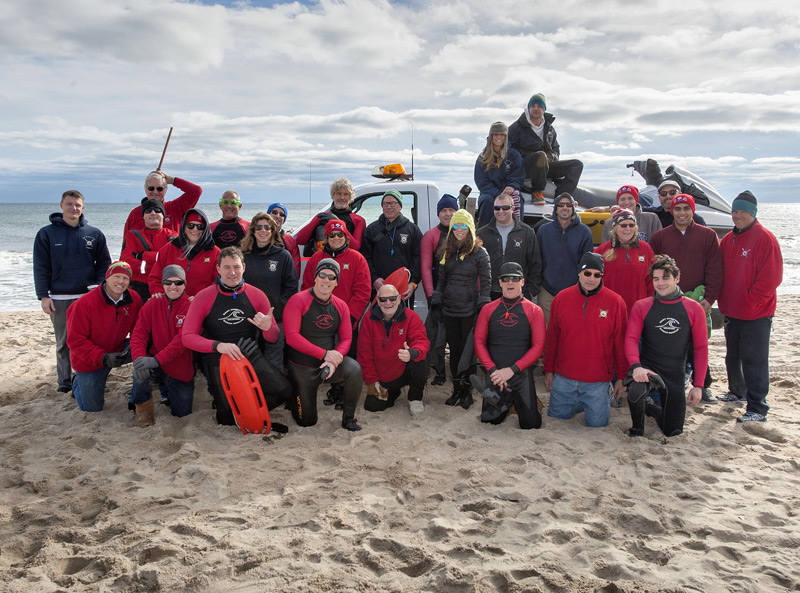
East Hampton Volunteer Ocean Rescue responds to distressed swimmers all year.
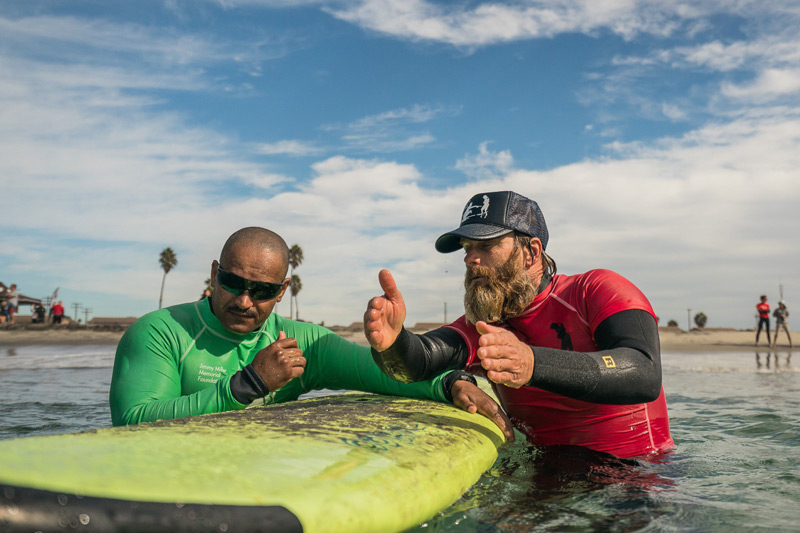
Teaching surf therapy with the Wounded Warriors.
Anyway, back to that board, which is a danger to those around you if you don’t hold onto it, so… please keep a grip. Yes, hold onto it. Get flipped upside-down with it, but don’t let go. It’s a free ride back to the surface, which is where we can all do something we enjoy…breathe. Without your board you’re still doing back flips underwater, board dragging you by the leg and perhaps endangering someone else. So please… HOLD ONTO YOUR BOARD. If you can’t, put on your HAND HELMET.
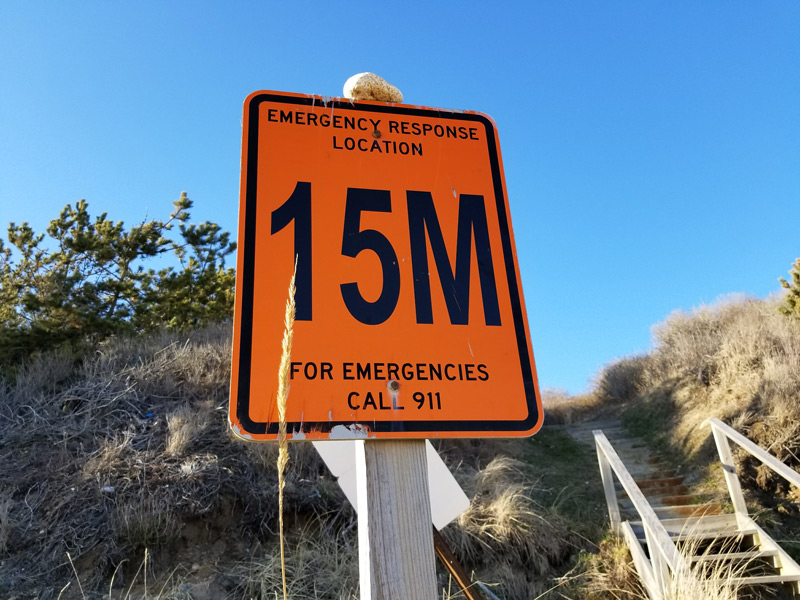
Note these location signs on the beach. 911 will ask you for the number in an emergency.
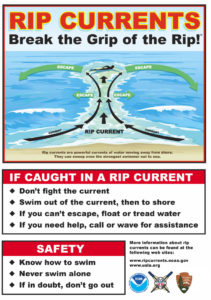
Don’t panic, know this sign.
Okay… that said, so what if the &#*! does happen on the water? First, don’t panic, this is just a story. Second, don’t panic at the time of an incident. Panic is not good. I’m sharing these thoughts so you can think ahead about having a plan and not succumb to panic. So thank you, again, for not panicking, but instead keeping a level head and knowing how to ask for help.
Would I be aware if someone needed help? How would I contact help? The answers should be known by every parent and, really, any beachgoer. Indeed, the town has a dedicated 911 response system for ocean emergencies for which I and about seventy other men and women carry pagers for rapid reaction. Behind this system is East Hampton Volunteer Ocean Rescue (EHVOR), which was created to respond quickly to emergencies with lifeguards and equipment to make ocean rescues.
If you do need to call 911, here is a big tip that many overlook: note the letter and number of the big ORANGE sign staked at every public beach entrance. The 911 operator will ask you for it, making our response time faster.
Simple awareness of our surroundings… the surf, rips, rocks, lifeguards, and of course that big ORANGE sign… can make our summer fun safer. So please remember that old saying about how it’s all fun and games until &#*! Let’s work together to keep it safe. Hold onto those boards as best you can out there, and when you can’t, remember to cover your head, especially on the way back up to the surface.
Please be aware or your environment…just in case.
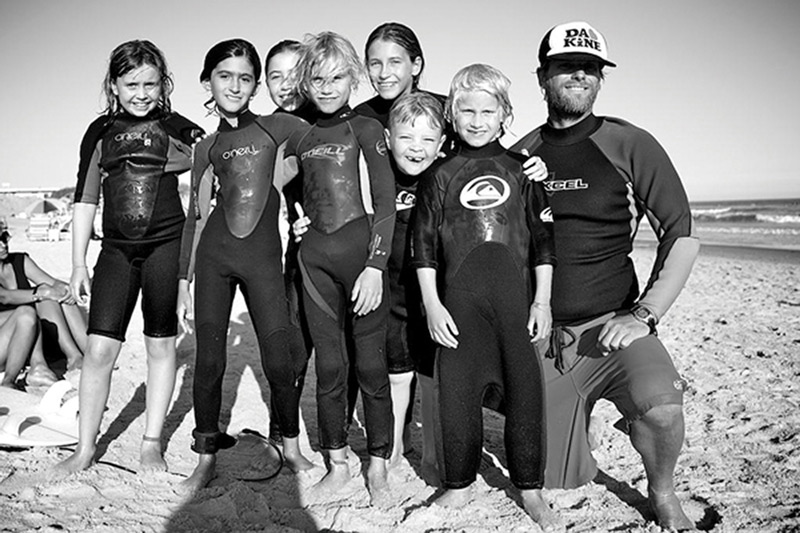
Bob Miller and his open water swimmers at Ditch Plains.
Part II
Let’s Tauk Surf Etiquette
So…. the story goes… after forty years of catching waves (that I can remember) I’ll share with you what I’ve learned. “Share”, hmmm … that was my mantra a few years back, so while out in the water surrounded by perhaps more than the usual crowd of local surfers, I’d find myself taking a deep breath in …. 2,3,4 … and on the exhale remind myself to share.
Anyhow that is the sort of thing that this article is about. After coaching for over 25 years and specifically surfing the past 15 years I’ve learned to keep it simple. Some of you may be familiar with the acronym KISS, which stands for keep it simple silly (yeah right,) so I’ll keep it silly, I mean simple.
When talking about surfing we can talk about 3 different things… safety, which we talked about in the last article (HOLD YOUR BOARD… COVER YOUR HEAD), etiquette, which we will learn about in this article, and then we can talk surfing, but if you learn to be safe in the water and practice good etiquette… you can surf anywhere in any line-up around the world.
That said, I’ve often asked people what etiquette is…. and their answers are great! The dictionary defines etiquette as ‘the customary code of polite behavior in society or among members of a particular profession or group,’ & that group would be us…surfers.
With no one out in the ocean to police the line-up, this ‘code of polite behavior’ is not always understood, acknowledged, or perhaps even known, so I’m going to share.
I’m going to write down those unwritten rules of conduct, courtesies, & customs, which is not something new. Manners are something we’ve all learned in grammar school. Like taking turns on the slide, a surfing line-up works like a queue – everyone gets a slide, I mean ride… or slide… whatever, y’all know what I mean, protocol.
These formalities with respect to surfing are as relevant today as they were back in the day when The Beach Boys put out their album, “Pet Sounds,” and without a certain decorum, the ocean would be a much more dangerous place… which again brings us back to safety because if it’s not safe and people aren’t nice, surfing is much less fun.
Anyway … let’s get into this surf etiquette stuff.
Nicety numero uno is DON’T DROP IN. This means that you look both ways before taking a wave. It’s like crossing the street, if you look one direction and someone is coming…you don’t go, pull back on your board, sit on the tail, kick out of the wave. DON’T DROP IN and from our first article on safety, HOLD ONTO YOUR BOARD.
Another rule of conduct is DON’T BE A SNAKE. This would mean to paddle around other surfers in the queue and basically cut the line. Imagine that slide again in the playground, and those surfers that are snakes would be the type that didn’t want to wait their turn, pushing, pulling, causing drama, not good!! DON’T BE A SNAKE, please wait your turn and remember breath in 2,3,4 & … “share.”
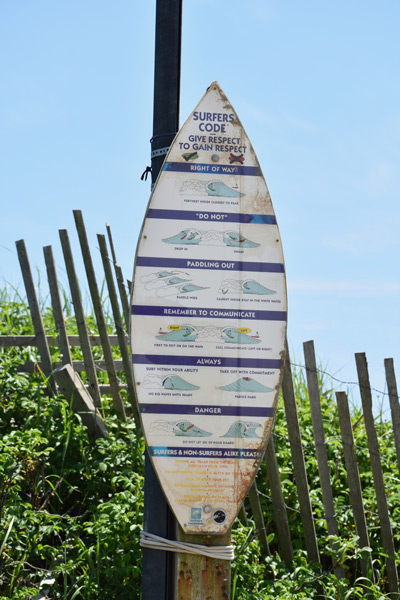
Surfers Code Sign at Ditch Plains

Bob Miller helps rescue refugees in Greece.
Okay… courtesy #3 is to take CAUTION ON THE INSIDE. Here we mean when caught inside the breakers, to paddle towards whitewater to avoid a collision; and ONLY IF IT IS SAFE TO DO SO, paddle towards the shoulder of a wave to avoid a collision. Basically, do anything you have to get out of a surfers way that is riding, which brings us back again to our “safety tauk” from the spring On Montauk, & being aware of your surroundings.
Next, good form in the ocean is to NEVER lose or throw your board. My lifeguard Captain says, “back when there were no leashes, and if you couldn’t swim and you lost your board you died, so… that really cut down on the crowds quite a bit.” That makes for both good etiquette & good safety… HOLD ONTO YOUR BOARD.
Are you seeing patterns of formality here, like WAIT YOUR TURN? So, who’s turn is it? The person waiting the longest, closest to the peak or furthest out, some would even say the first up, but it’s really about polite decorum & sharing.
One last formal politesse please, if I may…? SURF WITHIN YOUR ABILITY. As in if you’re learning, please stay clear of the main surf zone, again please, take the time to learn how to control your surf board away from the crowd.
These are all ways to practice good surf etiquette, which again is defined as the customary code of polite behavior… so, please be aware of your surroundings, wait your turn, don’t drop in, don’t be a snake, and hold onto your boards.
Sent from my lifeguard stand…
Part III
Now Let’s Hit the Waves
So now that we have covered the basics in safety, HOLDING ONTO YOUR BOARD & COVERING YOUR HEAD, followed by some rules of etiquette like DON’T DROP IN or SNAKE another surfer, we can now begin to talk about surfing.
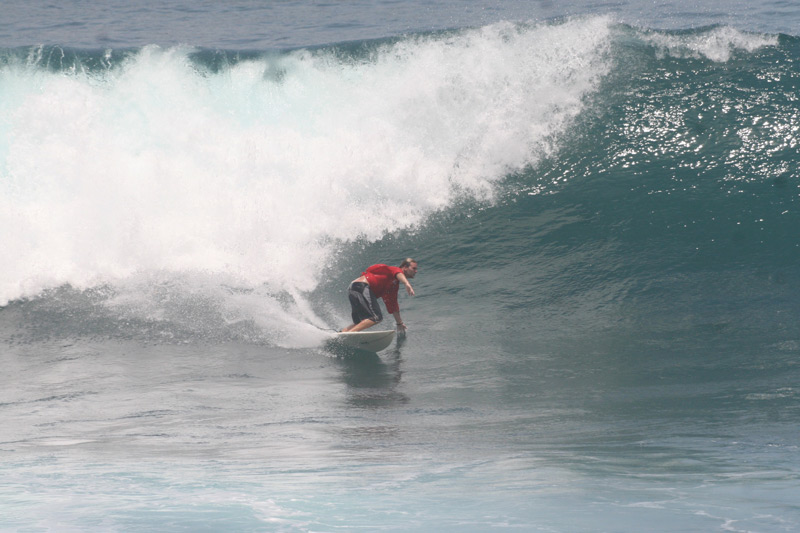
Bob Miller in action
I’ll begin by discussing how to control your surf board, where if you were to draw a line down the middle of your longboard, cutting it in half length wise, you will discover the center of buoyancy or balance of the board.
Hypothetically you would be able stand there on one foot, right in the middle of the board, but that is pretty difficult, so you can put the other foot down too, but it is that front foot that will control the speed of your board.
If you put weight on this front foot your board will move forward, as if it is the gas peddle and then the back foot would be the opposite or the brakes, like when you want to slow your board down, you put weight on that back foot.
That said, the same place you put your front foot is where your hands were when you pushed up on the board as you were standing up, therefore your hands also control the speed at which you go.
If you keep your weight over your hands on your board it will continue moving forward but, if at this time, you put your knee down on the back of the board it will also be like putting on brakes and you will miss the wave you’re going for.
So let’s now get into your position on this surf board and the understanding that as you lay down you may need to slide forward or back on that board again depending on how fast you’d like to go.
If you look over your shoulder at the wave coming and you see that it is a bit big you can slide back a little, while if looking over your shoulder you see a small wave that you’d like, slide forward…and it is through remembering to do this, on every wave, you’ll find more success.
Speaking of success, the more waves that you go for the more you will fail… I mean succeed, but it will be through this failure that you will learn to succeed, sort of like life, anyway….
When you decide that you are going to go for a wave you must keep in mind your surroundings, as in look where you are going, look to the left and right to see if someone is coming, and look behind you at the wave approaching.
If something does not look safe, if there are people in the way, please change your direction, avoid other people, or even decide not to take the wave and wait for another one. If it looks good, then decide if you need to go faster or slower to catch the wave.
As you paddle for the wave, just before the wave comes up behind your feet, take two or three more hard paddles to keep your momentum going as you jump to your feet, with either your weight forward or back depending on the size of the wave.
If it’s big wave you may want your weight on the back foot to slow it down and keep the nose of the board up or for a small wave keep that weight over the front foot until you’ve taken off.
Once you’ve made this initial adjustment of your weight, either forward or back, you can then shift the weight, again, forward or back, to control the speed at which you are surfing and perhaps even begin to turn your board.
But… let’s not get ahead of ourselves… we still need to get out into the ocean, beyond the breaking waves, before we can begin to catch clean green waves, or we’ll be simply riding white water on the inside.
So as you enter the water you’ll want to consider a few things, like where the bigger waves are breaking, if there is a rip current that can take you out there, and even the interval between waves and sets of waves.
Then when you enter the water it is important to keep your board pointing straight out toward the ocean or toward the beach. If your board is sideways when a wave hits you, your board may be flipped back at your head, and well … that might be a bit painful.
Okay, so a wave is approaching you as you’re walking into the water. If you are moving toward it with some momentum it will not push you backwards as far. If you stand still and let it hit you, well, then it is going to do just that, and likely knock you back.
The more momentum you have moving forward when you come in contact with the white water the less it will push you back. If you are on your board paddling when the white water gets to you, hold the rails with both hands and push yourself up so the water can pass beneath you.
If there is a large wave coming your way please do not just bail your board…remember our safety rule of holding onto your equipment. What you need to do is keep your momentum forward and, before the wave hits you, hold the rails and roll the board upside down.
This move is called a turtle roll and will allow this wave to crash down on the board, and not on your head, because now you are underneath it. The wave will push the board down under the wave and then your board will float back up on the other side, so hold on for the ride.
Now that you have gotten yourself out the back remember all the things we have covered so far about safety, etiquette, and surfing. Remember the more waves you take the more chances you have to fall… I mean stand up, but it is through falling that we learn to stand, sort of like life.
Surfing is a wonderful pastime, sport, or even form of therapy for many people, that can last a lifetime. But remember that it can also end your life if you’re not careful out there, so please keep safety in mind, and etiquette, while surfing in the ocean.
And if I may suggest taking a lesson when you’re beginning so that you can be reminded of these things again. Perhaps even by me, Bob, who’s been coaching surfing for over fifteen years @Air & Speed surf shop in Montauk. (Good promo aye?)

